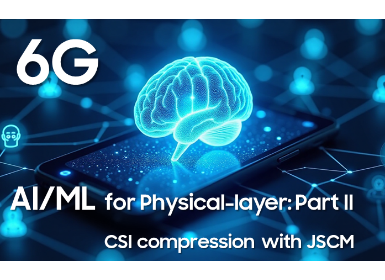Communications
5G Application Standards: Enabling B2B Services
3rd Generation Partnership Project (3GPP), in Release 15 (2017) formally kicked off the much anticipated efforts on 5G standardization. With the emergence of Industry 4.0, and from the very beginning, 5G emphasizes capabilities beyond increased data rates and lower latency, and even advances typically expected by consumers with every new generation. 5G standards place a strong emphasis on the integration of vertical industries with the 5G ecosystem, i.e., to extend communication beyond smartphones and towards smarter vertical industries, and beyond traditional telecom services to include vertical services. To support this vision, 3GPP SA6, the applications working group within 3GPP, established a clear roadmap under Samsung leadership. I have actively contributed to this working group as chair and vice chair from its foundation. With the initiatives of a dedicated team of researchers from Samsung Research, SA6 has triggered various application standards initiatives to improve integration of vertical applications with the 3GPP 5G ecosystem. The objective is to accelerate the adoption of 5G in vertical domains, commonly referred to as business-to-business (B2B) services.

Figure: 5G Application Standards
Origin of SA6
The first ‘vertical application’ that SA6 took on was Mission Critical Services (MCX). This was done during the late days of 4G standards development, expanding substantially through Release 14 (2015). Initially the features supported on existing narrow band critical communications infrastructure was targeted (push-to-talk), and further expanding to broadband services – video and generalized data capabilities. This has led to the establishment of a successful global standard for broadband mission critical communications, which are now being deployed in various countries, led by FirstNet (USA), and SafeNet (Korea). These services include Mission Critical Push-to-Talk (MCPTT), Mission Critical Video (MCVideo) and Mission Critical Data (MCData).
Moving beyond Mission Critical Services
As the MCX specifications matured, and with the rise of interest from other vertical industries such as Railways, Samsung grasped an opportunity to expand the range of application standards. As a result, under Samsung leadership in cooperation with other partner companies, SA6 initiated an expansion of its charter. Initially, there was hesitancy and opposition to expanding 3GPP application standardization efforts beyond MCX services. With persistence and leadership from Samsung, the 3GPP community finally agreed to the renewed and expanded SA6 Terms of Reference (ToR). Since then the working group addresses a broad range of application standards, elaborated here.
SA6 pursued diverse new opportunities, as both 3GPP and the larger mobile industry broadened their field of activity from traditional telecom services to include B2B services. With this new mission, SA6 was able to initiate activities on new 5G service frameworks that provide a general and feature-rich foundation for support of diverse applications, associated with different vertical sectors. Capabilities defined for MCX and other services can now be provided for an expanding set of services. Already, these application enablers support vertical-specific application standards for Vehicle-to-Everything (V2X), Unmanned Aerial Systems (UAS), Smart Factory and Internet of Things (IoT) applications. SA6 has come a long way towards support for a wide variety of 5G Application Standards.
5G Service Frameworks
5G service frameworks, which are introduced here, simplify and abstract the capabilities of underlying 5G system, allowing 3rd party applications to rapidly develop and deploy new vertical services over 3GPP networks.
The Common API Framework (CAPIF) offers a single point of entry for 3rd party applications, with the ability to uniformly discover and securely access the underlying 3GPP capabilities through API exposure. On the other hand, the Service Enabler Architecture Layer (SEAL) provides a “common services layer” including a set of core service capabilities such as group management, location management, device configuration, network resource, identify and key management functionalities that are common to industry verticals. The motivation is largely to avoid redefining the individual services for each vertical industry, thereby lowering the deployment costs for operators, and significantly reducing the barrier of adoption and the time-to-market for integrating new verticals to the 3GPP ecosystem.
Finally, the goal of the Edge Application Architecture (EDGEAPP) framework has been to enable native support within 3GPP network for hosting edge computing applications, while consolidating edge computing standardization in 3GPP. The edge computing framework provides various capabilities such as service provisioning, rich discovery of the edge applications, service continuity between multiple edge networks, interworking with the core network, and APIs for edge applications to integrate with the edge hosting environments.
5G Vertical Application Enablers
While 5G service frameworks offer horizontal capabilities, SA6 has also introduced vertical application-enabling initiatives that cater to vertical-specific application developers. These initiatives leverage the horizontal capabilities offered by 5G service frameworks by ‘layering on top’ and employ their services. In addition, 5G vertical application enablers offer specific customized features meeting the requirements of individual verticals. For example, V2X application support includes support for tele-operated driving, Quality-of-Service (QoS) negotiation, and service configurations for vehicle platooning. In Release 16, the first vertical enabling specification “V2X Application Enabler” (V2XAPP) was completed and has been successfully adopted by the 5G Automotive Association (5GAA). SA6 sustained this momentum, pursuing initiatives in Release 17 in the areas of UAS, Smart Factories and IoT messaging to be also embraced by relevant industry organizations such as ACJA, 5G-ACIA, and GSMA. These activities have not yet completed at the time this blog entry was written.
Conclusion – the BIG Picture!
Over of the last four years, including three major releases of 3GPP (Releases 15 to 17), the SA6 working group under the technical leadership and chairmanship of Samsung Research has established a strong foundation for integration of 5G vertical applications with the 3GPP ecosystem. With the various application-layer standards initiatives explained above, we have established a core set of 5G application standards which can help accelerate the deployment of 5G applications and services across multiple industry verticals. It is expected that these efforts will further expand in future 3GPP releases. Samsung is committed to continue its leadership in the promising journey ahead!






